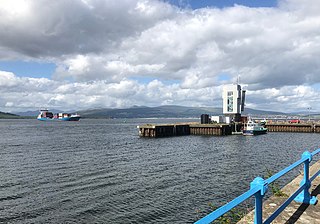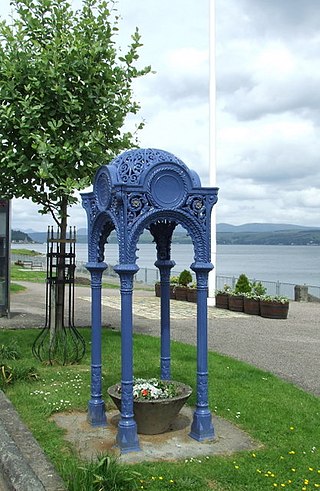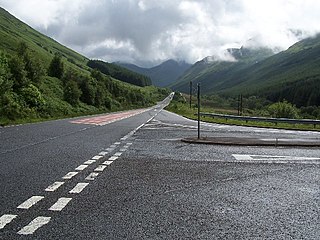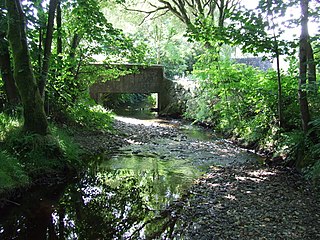
Argyll and Bute is one of 32 unitary council areas in Scotland and a lieutenancy area. The current lord-lieutenant for Argyll and Bute is Jane Margaret MacLeod. The administrative centre for the council area is in Lochgilphead at Kilmory Castle, a 19th-century Gothic Revival building and estate. The current council leader is Robin Currie, a councillor for Kintyre and the Islands.

Dunoon is the main town on the Cowal peninsula in the south of Argyll and Bute, Scotland. It is located on the western shore of the upper Firth of Clyde, to the south of the Holy Loch and to the north of Innellan. As well as forming part of the council area of Argyll and Bute, Dunoon also has its own community council. Dunoon was a burgh until 1976.

Helensburgh is an affluent coastal town on the north side of the Firth of Clyde in Scotland, situated at the mouth of the Gareloch. Historically in Dunbartonshire, it became part of Argyll and Bute following local government reorganisation in 1996.

Inveraray is a town in Argyll and Bute, Scotland. It is on the western shore of Loch Fyne, near its head, and on the A83 road. It is a former royal burgh, the traditional county town of Argyll, and ancestral seat to the Duke of Argyll.

Argyll, sometimes called Argyllshire, is a historic county and registration county of western Scotland.

Cowal is a rugged peninsula in Argyll and Bute, on the west coast of Scotland. It is bounded on the west by Loch Fyne and on the east by Loch Long and the Firth of Clyde. The Kyles of Bute separate it from Bute to the south.

The Holy Loch is a sea loch, a part of the Cowal peninsula coast of the Firth of Clyde, in Argyll and Bute, Scotland.

Loch Long is a body of water in the council area of Argyll and Bute, Scotland. The Sea Loch extends from the Firth of Clyde at its southwestern end. It measures approximately 20 miles in length, with a width of between one and two miles. The loch also has an arm, Loch Goil, on its western side.

The Tail of the Bank is the name given to the anchorage in the upper Firth of Clyde immediately North of Greenock, between Inverclyde and Argyll and Bute. This area of the Firth gets its name from the deep water immediately to the west of the sandbank which marks the entrance to the navigable channel up the Estuary of the River Clyde.

Strone is a village on the Cowal peninsula in Argyll and Bute in the Scottish Highlands at the point where the north shore of the Holy Loch becomes the west shore of the Firth of Clyde. The village lies within the Loch Lomond and The Trossachs National Park.

Kirn is a village in Argyll and Bute in the Scottish Highlands on the west shore of the Firth of Clyde on the Cowal peninsula. It now forms part of the continuous habitation between Dunoon and Hunters Quay, where the Holy Loch joins the Firth of Clyde. It originally had its own pier, with buildings designed by Harry Edward Clifford in 1895, and was a regular stop for the Clyde steamer services, bringing holidaymakers to the town, mostly from the Glasgow area.

Strachur and Strathlachlan are united parishes located on the Cowal peninsula, in Argyll and Bute, Scotland. Strachur is a small village on the eastern coast of Loch Fyne.

The A815 is a major road located in Argyll and Bute, Scotland. It runs for about 37 miles (60 km) from the A83, near Cairndow, in the north to Toward in the south. It passes beside three lochs, while its final stretch is along the Firth of Clyde.
"The Selfish Giant" is a song recorded by English recording artist and songwriter and Blur frontman & Gorillaz creator, Damon Albarn, from his debut solo studio album Everyday Robots. The track features Natasha Khan, known professionally as Bat for Lashes. The track is produced by both Albarn and Richard Russell, whom Albarn has previously worked with on Bobby Womack's comeback album The Bravest Man in the Universe and on the DRC Music album Kinshasa One Two.

Dunoon Burgh Hall is a municipal structure in Argyll Street, Dunoon, Scotland. The structure, which is used as an events venue, is a Category B listed building.

Robert Alexander Bryden was a Scottish architect, prominent in the second half of the 19th century. He was mainly active in the west of Scotland, where he designed schools, churches and municipal buildings.

Clarke & Bell & R. A. Bryden was a major Scottish architectural firm based in Glasgow, created by William Clarke (1809–1889), George Bell (1814–1887) and Robert Alexander Bryden (1841–1906) around 1875. The practice dissolved in 1902, but several of their designs are now listed buildings.
St Cuthbert's Church was a church building in the Scottish town of Dunoon, Argyll and Bute, Scotland. It was built in 1874, to a design by noted architect Robert Alexander Bryden, who also designed the adjacent Dunoon Burgh Hall around the same time. The church stood for 120 years, before being demolished in 1994. A block of flats, erected in 2016, now stands on the site at 191 Argyll Street. A planning application was first made for a similar construction in 1998.

Milton Burn is a watercourse in Argyll and Bute, Scotland. It is sourced from Loch Loskin in Kirn and largely runs parallel to the A885 road as it leads south to Dunoon. It is around 1.02 miles (1.64 km) long.
James MacArthur Moir was a Scottish miller and laird. He owned a large tract of land in Dunoon, Argyll and Bute, which was partly built on his Milton estate. McArthur (sic) and Moir Streets in the town are named for him.

















